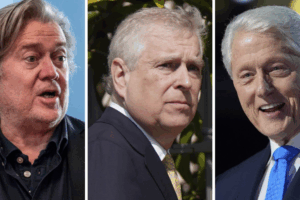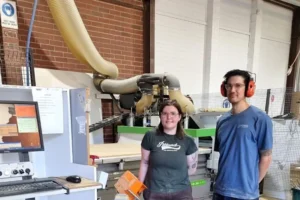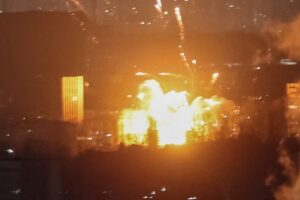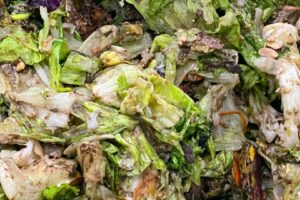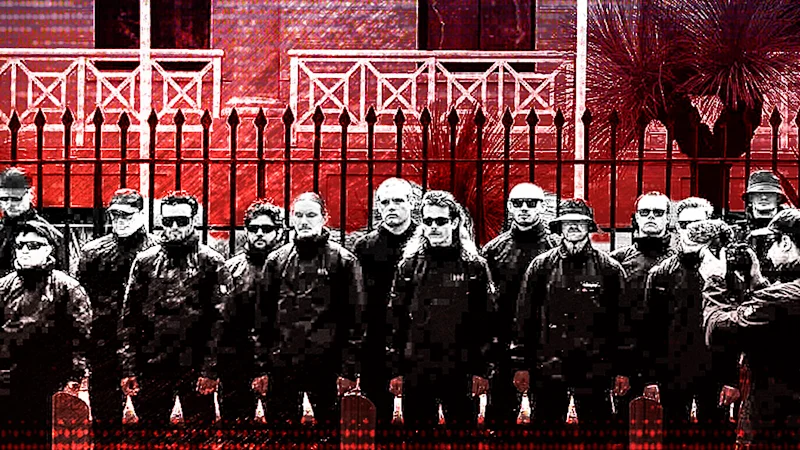
Normal text sizeLarger text sizeVery large text size
Jack Eltis speaks like a manager from human resources. He talks about onboarding, organisational culture and “going forward”; he discusses recruitment strategies and behavioural expectations. Yet in the next breath, the neo-Nazi will say something so vile it’s difficult to comprehend how such an idea could be spoken by anyone, let alone a 28-year-old air-conditioning mechanic from north-west Sydney.
His management jargon is interspersed with descriptions of the Holocaust as a narrative, and claims that people from India have “a median IQ of sub 80”. His PowerPoint slides about the National Socialist Network’s tactics discuss a chilling goal. “We want to deport all third-world immigrants and Jews as well, regardless of how they feel about that,” he says. “The sensitivities of Jews and third-world immigrants are not our concern.”
This cushioning of the extreme with the mundane is deliberate. The NSN is trying to come out of the shadows. “The strategy is to normalise their name,” says Mario Peucker, who studies the dynamics of right-wing extremism at Victoria University, “to take the edge off a bit.” They want to make themselves acceptable to that rump of the community that might recoil at the extremes of Nazism but still wants Australia to be white.
Jack Eltis mixes management-speak with neo-Nazi talking points.Credit: Nine News
Last Saturday’s rally in front of NSW Parliament was a neo-Nazi attempt at exposure therapy. They protested with permission and they obeyed the rules. They took their balaclavas off. Their banner singled out not the Jewish people but the Jewish “lobby”, which has also been a target of the political left. The Hitler Youth reference to “blood and honour” was spoken rather than written, so it didn’t feature in their promotional pictures.
But their worldview hasn’t changed. They are still followers of Adolf Hitler. And they are no longer a bunch of boys playing a hateful game; in the view of Levi West, a terrorism authority from the Australian National University, the growing neo-Nazi movement is “the single greatest threat to Australia’s liberal democracy”.
Politicians, police and extremism experts disagree about how to handle the NSN, particularly as it advances its plans to set up a political party. Perhaps it should be ignored, like an attention-seeking toddler. Perhaps public shaming will erode its support. Perhaps it should be banned under terrorist laws and driven off the streets, but potentially into more threatening activities underground. They agree on one thing; Australia needs to address the social issues – loneliness, grievance – that are fomenting its appeal.
If the NSN gets the signatures it needs to register a political party (it claims to be close to meeting the federal electoral requirements), it won’t be the first neo-Nazi movement to do so. And in a country that enshrined its whiteness in policy until the 1970s, the idea hasn’t always been so shocking. The National Front of Australia ran candidates in the 1980 federal election. Ross “The Skull” May (who did several stints in jail for bashing people while dressed in a Nazi uniform) ran against Gough Whitlam in 1974. When he ran in a Parramatta byelection, both major parties preferenced him over each other (he still didn’t get many votes).
Loading
Historically, Australian neo-Nazi movements have tended to fizzle out or self-destruct. In the 1980s, the implosion of National Action and the Australian Nationalists Movement led to stabbings, deaths and the murder of a skinhead at a birthday party for Hitler by the neo-Nazis who inspired the movie Romper Stomper. Since then, violence by the extreme right in Australia has significantly decreased.
The latest resurgence of the neo-Nazis came about 10 years ago, during heightened Islamophobia after the Lindt Cafe siege. A series of splits and mergers over the past decade – Reclaim Australia, the United Patriots Front, the Lads Society – has led to a single organisation, with an undisputed leader in ex-soldier (and New Zealand immigrant) Thomas Sewell, backed by a team of loyal lieutenants. It’s hard to tell, but some experts believe it’s the biggest neo-Nazi movement in Australia’s post-war history.
Learning lessons from past failures, the NSN is trying to replace brutality and chaos with ruthless efficiency (they’re still abusive, aggressive and menacing). “Incidents of fatal or near-fatal far-right violence in Australia have declined since the 1990s,” says University of Canberra researcher Jordan McSwiney, “but at the same time, the far right is more visible and active than ever before.”
Thomas Sewell is the leader of the NSN.Credit: AAPIMAGE
Eltis is one of Sewell’s lieutenants. He was in his late teens when he began exploring neo-Nazi ideas online. A few years later, “when I’m the only white guy on a train full of Indian people”, he decided to act. He joined the NSN and ticked off its initiation and character requirements; reading the party manifesto, Adolf Hitler’s Mein Kampf; attending military-style training sessions with inverted Swastika flags, and drinking raw milk (the movement is also unashamedly misogynist, has odd dietary preferences, and it believes wearing eyeglasses is a sign of weakness).
They run a tight ship. In a PowerPoint presentation Eltis, head of the NSW chapter, says the UPF failed because its leadership was a mess. This new group would be disciplined, keeping members engaged with physical training and political meetings. It would also have a publicity arm, to produce propaganda content and to manipulate the media. Their proposed White Australia party was intended to get attention as much as to get their hands on the gears of government.
“[We want to] build an organised, disciplined group of men who can demonstrate to the public that they are capable of running the nation,” said Eltis. Or as independent researcher Kaz Ross put it, the NSN wants to convince the world that NSN’s neo-Nazis are “nice and polite and don’t bash people”.
But they’re not nice and polite, and they do bash people. Since he took on the job as the nation’s top spy boss in 2019, ASIO director-general Mike Burgess has repeatedly sounded the alarm about the rising threat of neo-Nazi groups in Australia. Since February 2020, he has warned of salutes to Nazi flags, weapons (NSW Police confiscated Eltis’ firearms in April 2023) and the radicalisation of teens. In 2021, half of ASIO’s most important domestic anti-terrorist cases involved neo-Nazi cells and other ideologically motivated groups.
Just last week, in a speech to the Lowy Institute, Burgess again raised concerns about the NSN’s attempt to hijack community concerns about immigration, housing and cost of living to build its profile and legitimacy. He warned of “the hateful, divisive rhetoric and increasingly violent propaganda, and the growing likelihood these things will prompt spontaneous violence, particularly in response to perceived provocation”.
Lost souls searching for meaning online, particularly teens and young men, are a rich recruitment seam. Neurodivergent teens are particularly vulnerable. The NSN is skilled in offering a warm embrace that turns into a cage. “If you have someone who doesn’t know how to fit into the world, doesn’t know how to talk to women, what to wear, who to be, it will tell them exactly what to do,” says Charles Sturt University extremism expert Kristy Campion. “It’s very prescriptive.”
As McSwiney says: “People join extremist groups for pro-social reasons. They find friendship, companionship, relationships; that’s primarily why people join, and why people stay. Extremist belief comes after ideological commitment. If all your friends are Nazis, it’s easier to become a Nazi.” He and other experts say Australia doesn’t have enough programs to prevent people being radicalised, or to help extract them when they want to leave.
But people who have already drifted to the far right are also a target. The anti-immigration March for Australia was a boon for recruitment. The NSN had a prominent organisational role; in Melbourne, Sewell was the march leader. Only a handful of NSW NSN members were involved in a balaclava-clad stunt on a Sydney train on Australia Day last year. On Saturday, there were more than 60. The NSN itself boasts of nearly 100 members in NSW, plus affiliates.
In NSW, the NSN is also trying to avoid the violence that has marked the organisation’s Victorian branch. There, leaders – including Sewell – have been in and out of jail on charges such as violent disorder and affray. There was a cruel attack on an Indigenous camp. “We don’t see issues here in NSW like they do in Victoria,” NSW Deputy Police Commissioner David Hudson told the parliamentary committee. Eltis says it’s because there are more left-wing activists in Victoria, from which the “guys will defend themselves”, and because “police [in NSW] are more diligent at handling protests”.
While their views are repulsive, police don’t think the NSN is plotting lethal attacks. They say the greatest threat to the physical safety of Australians lies in so-called lone wolves who adopt its ideology. Brenton Tarrant was one of these. Sewell had tried to recruit him to the Lads Society, a precursor to the NSN. Tarrant made a donation but refused to join, and went on to kill 51 people in two mosques in New Zealand.
Loading
Yet McSwiney says groups like the NSN feed lone wolves. “They are always deeply plugged in to this movement, its ideology, its strategy; they’re following the movement’s influences.” On Thursday, police revealed a teenage boy in Canberra had plotted with like-minded neo-Nazis to livestream a chemical attack. Last June, a 19-year-old with a right-wing manifesto was charged with attempting to kill a local MP.
There’s no clear answer to stopping the NSN. Amid questions about why the NSW Police allowed the protest to go ahead on the grounds that they couldn’t find any legal reason to stop it, and as officers look at whether they can charge the men at the rally with new hate speech offences, NSW Premier Chris Minns has flagged more legislation that would broaden bans on Nazi symbols to cover slogans such as the Hitler Youth reference “blood and honour”.
Extremism experts say that might be a useful tool for police, but that it wouldn’t deter the NSN. Germany’s laws haven’t stopped the neo-Nazi movement from flourishing there. “The German example comes with a litany of compulsory education stuff for kids at primary school onwards,” says West from the ANU.
The Australian groups already come up with obscure ways to reference Hitler’s regime. At the March for Australia, they wore Helly Hansen-brand raincoats (for the initials HH). They used to wear a khaki bomber jacket over a Lonsdale shirt to reveal only the letters NSDA, the initials of the early Nazi party.
Loading
Another option could be to proscribe the NSN. Burgess has acknowledged the difficulties in responding within the current laws, which stipulate a group must be directly or indirectly engaged in preparing a terrorist act or advocating for a terrorist act in order to be listed as a terror organisation. Law enforcement and politicians say the neo-Nazi groups have so far managed to stay on the right side of the terror definition.
Yes, there have been eruptions of violence, but they consider these hate crimes rather than terror attacks. “They are very good at walking up to the line and not crossing it,” a senior figure in the national security community says, speaking on condition of anonymity to discuss sensitive matters. Another official says: “We are all going to have to engage in some creative thinking.”
One option would be to water down the definition of a terror organisation so it captures the NSN. But this would need to be paired with reduced penalties. Another would be to create a new category of listed extremist organisation that would sit alongside the existing terror registry. Still, there is always the risk of far-right groups dissolving and rebranding themselves, or taking their activities underground.
In his Lowy speech last week, Burgess also raised the challenge of confronting neo-Nazism without giving it the publicity its adherents crave. “It gives them credibility and helps with recruitment,” he said. “They see journalists as ‘useful idiots’ in this regard.” Former British prime minister Margaret Thatcher had the same concern about the Irish Republican Army. “Starve the terrorist,” she once said, “of the oxygen of publicity.”
It’s a tricky balance, says Campion. “They’re aiming to bait the media,” she says. “At the same time, the Australian public has a right to be informed. We don’t censor our media.” Peucker says the question isn’t whether to report, but how. “The basic question is, would they benefit, or would they hate it? If you expose them and make them look weak and unhinged, or do you make them look strong?”
NSW Jewish Board of Deputies president David Ossip welcomes the coverage of Saturday’s rally. “This has been bubbling under the surface,” he says. “You have to expose these individuals. You have to go toe to toe with the ideology. It’s intellectually bereft; it’s built on lies. They’re aligning themselves with the ANZACs, but it’s the opposite – they’re actually aligned with the greatest enemy Australia has ever faced.”
Last Saturday’s rally might have led to a new law about Nazi symbols, an anxious public debate and a post-mortem about NSW Police communication, but West believes more is needed. He wants federal and state governments, police forces and national security agencies to nut out a national strategy to protect liberal democracy from the far-right threat.
Loading
It would look at prevention; how to channel disaffected, lonely teens into more positive communities. It would look at ways to address the grievances that are making people vulnerable to extreme beliefs. It would look at policing strategies and laws that could crack down on behaviour that is a threat to national security.
Most importantly, it would involve a broader project to bulwark liberal democracy from the threat of the extreme right. “[The NSN wants] to get enough power to destroy the society that lets them protest,” says West. “What we’re trying to deal with isn’t just about violence and terrorism. It’s about chipping away at our social cohesion.”
Cut through the noise of federal politics with news, views and expert analysis. Subscribers can sign up to our weekly Inside Politics newsletter.
